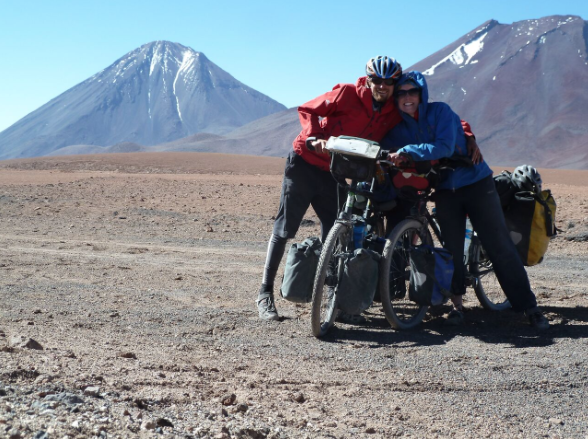
Do you sometimes have itchy feet and wish you could explore, learn and share about environmental and sustainable energy projects on the ground? This happened to us. We had both worked several years (and are now again), me as a sustainable energy consultant for E4tech, developing for example strategic bioenergy plans and evaluating its sustainability impacts. Sara as environmental economist for the Environment Department in London, analysing the costs and benefits of different policy options. Exciting projects that often looked at the big picture. But we didn’t know many of the on the ground realities, difficulties and solutions of sustainable energy or environmental projects in a development context. We were curious to discover what makes them successful in the long-term. On a bicycle. A one-year trip along the Andes of South America. I got inspired for such a trip many years before, when I met former oikos PhD fellow Tim Lehmann back at the oikos spring meeting in Reims in 2009. He told me about their trip “Expedition Welt” meeting numerous social entrepreneurs around the world, I read their book and it stayed with me for a while. oikos inspired me and motivated me to contribute actively. I was a member of oikos Reims in 2007, then co-founded oikos Budapest and was part of the Executive Board in 2010.
We set off to the largest city on earth with no road access, Iquitos in the Peruvian Amazon, to support Peruvian-British charity Plant your Future to implement a smartphone-based monitoring system to improve and inform expansion in their agroforestry schemes. With temperatures above 30C, high humidity and no roads, it was not the obvious place to start a one-year bike trip. But it was an ideal place to get properly involved in on-the-ground project work. Six weeks later we had set up the monitoring system, trained local staff to use it, learned about the importance of farmers’ monetary involvement for well managed agroforestry schemes, had all the Spanish agroforestry vocab ready to use and were motivated to get pedalling. After a boat on the Amazon for three days, we arrived at the first road where we could get our wheels on the ground. Roads, gravel paths and dirt tracks would lead us slowly south towards Patagonia before heading back up north to Ecuador and Colombia. On route, often with large diversions, we visited around twenty environmental and sustainable energy projects. We tended to organise project visits a few weeks before passing through an area by either reaching out to people in my network (international Mespom MSc, the IIIEE, oikos etc.), directly contacting NGOs or development organisation, or through chance encounters with interesting people on the way.

So, what did we learn about what makes a project or programme successful in the long-term? Our trip was far from academic research, rather an ad hoc collection of views of those who have initiated, or managed, or benefitted from certain schemes. Our blog will soon include our extended version, but for now, three examples to share:
- How to increase incomes (and reduce deforestation)? Think about the market before you start: We were faced with a number of farmers in Peru who, based on advice and specific credit from a Government scheme, dedicated their land to growing a the latest ‘trendy’, higher value crop, such as Sacha Inchi, or Palm Oil. They realised a few years later, with the mature crop loaded up, that there were no local buyers and that three day shipping along the Amazon to the closest processing facility was too expensive. Rather than improved livelihoods, these farmers were often left with monoculture, less food for their own families and debt to be repaid. In contrast, Amazónicos por la Amazonia (AMPA) in Peru had already sourced their high value market before they started encouraging farmers to designate a proportion of their rice paddies to growing shrimps. Chefs in Lima were clambering after these sustainable fresh-water shrimps, ensuring the farmers had ready buyers as soon as the first shrimps were ready.
- How to develop and maintain knowledge in a community? Stand-back: Mauricio, an inspiring Colombian renewable energy engineer who introduced us to a number of his successful community projects, told us he never ‘acts the engineer’. In the plains of Colombia, Los Llanos, he stood casually at the base of the wind turbine in construction, now and then providing assurance to the enthusiastic William, strapped to the turbine as he adjusted the blades. Mauricio never carries out any of the work himself. Turbines or irrigation technologies are constructed on site, by locals. Locals spend days slowly learning how to construct each part, understanding by trial and error why a screw shouldn’t go in a certain place.
- How to ensure a community´s involvement? Endev and Stichting Samay provided “no gifts” – families always had to contribute a proportion themselves – to ensure that there was a viable local market for potential businesses. Plus, the contribution – in money or time – would ensure that the services or products provided were actually something which the community wanted or needed. And, as a result, had the motivation to maintain – and make the service last for longer.
 At the end of the trip, we were guest speakers for Project Colombia, a social enterprise
At the end of the trip, we were guest speakers for Project Colombia, a social enterprise
with three arms: working with larger businesses to improve their social impact; teaching English to increase the opportunities of rural Colombians; training current and future entrepreneurs, through 4 week courses, sponsored by local mayors and the CSR budget of larger companies. They are always looking for people like oikees, be it via skype or in person, do get in touch with Nelson here if you would be interested in collaborating.
These are, of course, only what we have learnt on this specific route in a specific context, along the tarmac roads and gravel paths where our mountain-bike tyres have taken us. I am very happy to hear from you if you had similar experiences, planning to go on a learning journey or just would like to get in touch. If you happen to know anyone working for a cable car company (e.g. Doppelmayr), or a perfume/essential oil/bath products company, we are looking for financing to repair a cable car in a cut-off village in the Colombian Andes and for markets for lemongrass essential oil from a post-conflict area in Colombia. Do contact me through the “Submit” feature of our blog and I will email back.



